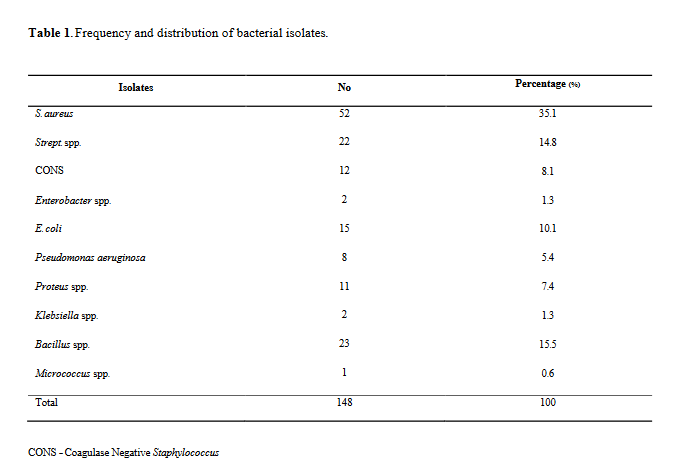Bacterial Contamination of Labor Wards and Delivery Rooms from Selected Primary Healthcare Facilities in Abia State
DOI:
https://doi.org/10.53848/ssstj.v10i1.413Keywords:
Bacterial isolates, Antibiotic, Susceptibility, Primary Healthcare CentersAbstract
Bacterial contamination of the labor and delivery room is of clinical concern because it is one of the major risk factors of sepsis in neonates and most life threatening nosocomial infections for mothers after undergoing childbirth procedures. From six different Primary Healthcare Centres (PHC), 300 samples of fomites were taken. They were screened for the presence of bacterial pathogens. Preliminary identification of bacterial isolates was performed based on Gram stain reactions and standard microbiological methods. Antibiotic susceptibility testing was done using Kirby- Bauer disc diffusion technique. The isolates of clinical importance observed were
Staphylococcus aureus (35.1%), Bacillus spp. (15.5%), Streptococcus spp. (14.8%), Escherichia coli (10.1%), Coagulase Negative Staphylococcus (CONS) (8.1%), Proteus spp. (7.4%), Pseudomonas aeruginosa (5.4%), Klebsiella spp. (1.3%). Eight (8) antibiotics used against Staphylococcus aureus which was the most prevalent isolate showed below 50% sensitivity. High level resistance to commonly prescribed and administered antibiotics was observed. The most frequently isolated bacteria in this study were consistent with the isolates which could cause nosocomial infections.
References
Bauer, A. W., Kirby, W. M. M., Sherris, J. C., & Turck, M. (1966). Antibiotic susceptibility testing by a standardized single disk method. American Journal of Clinical Pathology, 45(4), 493-496.
Cheesbrough, M. (2000). Manual of medical microbiology. UK: Oxford Press.
Ensayef, S., Al-Shalchi, S., & Sabbar, M. (2009).Microbial contamination in the operating theatre: A study in a hospital in Baghdad. Eastern Mediterranean Health Journal, 15(1), 219-223.doi:10.26719/2009.15.1.219.
Forbes, B. A., Sahm, D. F., & Weissfeld, A. S.(2007). Bailey & Scott’s diagnostic microbiology.St Louis: Mosby.
Garcia-Cruz, C. P., Najera Aguilar, M. J., & Arroyo-Helguera, O. E. (2012). Fungal and bacterial contamination on indoor surfaces of a hospital in Mexico. Jundishapur Journal of Microbiology, 5(3), 460-464.doi:10.5812/jjm.2625
Gebremariam, T. T. , & Declaro, M. F. F. ( 2014) .Operating theatres as a source of nosocomial infection: A systematic review. Saudi Journal for Health Sciences, 3(1), 5-8.doi:10.4103/2278-0521.130196
Hamza, R. (2010). Healthcare associated infections epidemiology. Revue Tunisienne d’Infectiologie,4, 1-4.
Nevalainen, A., Willeke, K., Liebhaber, F., Pastuszka,J., Burge, H., & Henningson, E. (1993). Bioaerosol sampling. In K. Willeke, & P. A. Baron (Eds.),Aerosol measurement: Principles, techniques and applications (pp. 471-492). New York: Van Nostrand Reinhold.
Okon, K. O., Osundi, S., Dibal, J., Ngbale, T., Bello,M., Akuhwa, R. T., ... Uba, A. (2012). Bacterial contamination of operating theatre and other specialized care unit in a tertiary hospital in Northeastern Nigeria. African Journal of Microbiology Research, 6(13), 3092-3096.
doi:10.5897/AJMR11.834
Omo- Aghoja, L. O. , Aisien, O. A. , Akuse, J. T. ,Bergstrom, S., & Okonofua, F. E. (2010). Maternal mortality and emergency obstetric care in Benin City, South- south Nigeria. Journal of Clinical Medicine and Research, 2(4), 55-60.
Onwubiko, N. E., & Akande, A. O. (2015). Microbial contamination in the operating theatre of a tertiary health institution in Kano, Northwestern Nigeria. Nigerian Journal of Microbiology, 27(1),2671-2679.
Orji, M. U., Mbata, T. I., & Kalu, O. U. (2005). Isolation of pathogenic bacteria from hospital staff apparel in Nigeria. Malawi Medical Journal, 17(4), 128-130.doi:10.4314/mmj.v17i4.10896
Saka, K. H., Akanbi, A. A., Obasa, T. O., Raheem, R. A., Oshodi, A. J., & Kalgo, Z. M. (2016).Pathogenic aerobic bacterial contaminants on non-critical hospital surfaces within paediatric ward of a Nigerian hospital. Journal of Medical Microbiology & Diagnosis, 5, 1-4.doi:10.4172/2161-0703.1000241
Singh, D., Kaur, H., Gardner, W. G., & Treen, L. B. (2002). Bacterial contamination of hospital pagers. Infection Control & Hospital Epidemiology, 23(5), 274-276.
Turner, A. G., & Craddock, J. G. (1973). Klebsiella in a thoracic ICU. Hospitals, 47(13), 79-82.
Weinstein, R. A., & Hota, B. (2004). Contamination,disinfection, and cross-colonization: Are hospital surfaces reservoirs for nosocomial infection? Clinical Infectious Diseases, 39(8), 1182-1189.













